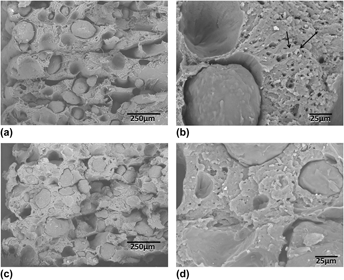Crossref Citations
This article has been cited by the following publications. This list is generated based on data provided by
Crossref.
Shemelya, Corey M.
Rivera, Armando
Perez, Angel Torrado
Rocha, Carmen
Liang, Min
Yu, Xiaoju
Kief, Craig
Alexander, David
Stegeman, James
Xin, Hao
Wicker, Ryan B.
MacDonald, Eric
and
Roberson, David A.
2015.
Mechanical, Electromagnetic, and X-ray Shielding Characterization of a 3D Printable Tungsten–Polycarbonate Polymer Matrix Composite for Space-Based Applications.
Journal of Electronic Materials,
Vol. 44,
Issue. 8,
p.
2598.
Torrado, Angel R.
Shemelya, Corey M.
English, Joel D.
Lin, Yirong
Wicker, Ryan B.
and
Roberson, David A.
2015.
Characterizing the effect of additives to ABS on the mechanical property anisotropy of specimens fabricated by material extrusion 3D printing.
Additive Manufacturing,
Vol. 6,
Issue. ,
p.
16.
Roberson, David
Shemelya, Corey M
MacDonald, Eric
and
Wicker, Ryan
2015.
Expanding the applicability of FDM-type technologies through materials development.
Rapid Prototyping Journal,
Vol. 21,
Issue. 2,
p.
137.
Weng, Zixiang
Wang, Jianlei
Senthil, T.
and
Wu, Lixin
2016.
Mechanical and thermal properties of ABS/montmorillonite nanocomposites for fused deposition modeling 3D printing.
Materials & Design,
Vol. 102,
Issue. ,
p.
276.
Spackman, Clayson C.
Frank, Christopher R.
Picha, Kyle C.
and
Samuel, Johnson
2016.
3D printing of fiber-reinforced soft composites: Process study and material characterization.
Journal of Manufacturing Processes,
Vol. 23,
Issue. ,
p.
296.
Boparai, Kamaljit Singh
Singh, Rupinder
and
Singh, Harwinder
2016.
Modeling and optimization of extrusion process parameters for the development of Nylon6–Al–Al2O3 alternative FDM filament.
Progress in Additive Manufacturing,
Vol. 1,
Issue. 1-2,
p.
115.
Siqueiros, J. Gilberto
Schnittker, Kevin
and
Roberson, David A.
2016.
ABS-maleated SEBS blend as a 3D printable material.
Virtual and Physical Prototyping,
Vol. 11,
Issue. 2,
p.
123.
Stansbury, Jeffrey W.
and
Idacavage, Mike J.
2016.
3D printing with polymers: Challenges among expanding options and opportunities.
Dental Materials,
Vol. 32,
Issue. 1,
p.
54.
Boparai, Kamaljit Singh
Singh, Rupinder
and
Singh, Harwinder
2016.
Process optimization of single screw extruder for development of Nylon 6-Al-Al2O3 alternative FDM filament.
Rapid Prototyping Journal,
Vol. 22,
Issue. 4,
p.
766.
Pohanka, Miroslav
2016.
Three-Dimensional Printing in Analytical Chemistry: Principles and Applications.
Analytical Letters,
Vol. 49,
Issue. 18,
p.
2865.
Picha, Kyle
Spackman, Clayson
and
Samuel, Johnson
2016.
Droplet spreading characteristics observed during 3D printing of aligned fiber-reinforced soft composites.
Additive Manufacturing,
Vol. 12,
Issue. ,
p.
121.
Rahim, Tuan Noraihan Azila Tuan
Abdullah, Abdul Manaf
Akil, Hazizan Md
and
Mohamad, Dasmawati
2016.
Comparison of mechanical properties for polyamide 12 composite-based biomaterials fabricated by fused filament fabrication and injection molding.
Vol. 1791,
Issue. ,
p.
020007.
Yang, Hui
Leow, Wan Ru
Wang, Ting
Wang, Juan
Yu, Jiancan
He, Ke
Qi, Dianpeng
Wan, Changjin
and
Chen, Xiaodong
2017.
3D Printed Photoresponsive Devices Based on Shape Memory Composites.
Advanced Materials,
Vol. 29,
Issue. 33,
Prashantha, K.
and
Roger, F.
2017.
Multifunctional properties of 3D printed poly(lactic acid)/graphene nanocomposites by fused deposition modeling.
Journal of Macromolecular Science, Part A,
Vol. 54,
Issue. 1,
p.
24.
Mohiuddin, Mohammed Viquar
Hussainy, Syed Ferhathullah
Krishnaiah, Arkanti
and
Laxminarayana, P.
2017.
Experimental investigation to produce thin-walled sand casting using combination of casting simulation and additive manufacturing techniques.
The International Journal of Advanced Manufacturing Technology,
Vol. 90,
Issue. 9-12,
p.
3147.
Meng, Shuna
He, Hui
Jia, Yunchao
Yu, Peng
Huang, Bai
and
Chen, Jian
2017.
Effect of nanoparticles on the mechanical properties of acrylonitrile–butadiene–styrene specimens fabricated by fused deposition modeling.
Journal of Applied Polymer Science,
Vol. 134,
Issue. 7,
Farahanchi, Azadeh
Boehm, Emily
Orbey, Nese
and
Malloy, Robert
2017.
The Effect of ultra‐high speed twin screw extrusion on ABS/organoclay nanocomposite blend properties.
Polymer Engineering & Science,
Vol. 57,
Issue. 1,
p.
60.
Xiaoyong, Sun
Liangcheng, Cao
Honglin, Ma
Peng, Gao
Zhanwei, Bai
and
Cheng, Li
2017.
Experimental Analysis of High Temperature PEEK Materials on 3D Printing Test.
p.
13.
Viskadourakis, Z.
Vasilopoulos, K. C.
Economou, E. N.
Soukoulis, C. M.
and
Kenanakis, G.
2017.
Electromagnetic shielding effectiveness of 3D printed polymer composites.
Applied Physics A,
Vol. 123,
Issue. 12,
Cao, Shiqing
Yu, Dandan
Xue, Weilan
Zeng, Zuoxiang
and
Zhu, Wanyu
2017.
Synthesis and properties of modified PBT for FDM.
Rapid Prototyping Journal,
Vol. 23,
Issue. 4,
p.
804.
